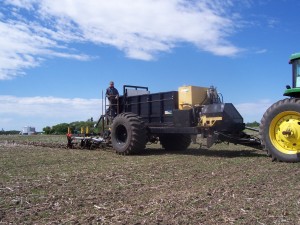Harry Siemens / Farmscape – Research conducted by the University Saskatchewan suggests a promising future for solid and semi-solid livestock manure fertilizer injection technology. Researchers with the university’s Department of Crop Science have released preliminary results of a three year study examining the agronomic and environmental implications of solid manure injection.
The study, which began in the spring of 2007, looks at crops grown on land fertilized with solid cattle manure applied using a prototype sub-surface applicator designed by the Prairie Agricultural Machinery Institute (PAMI) at Humboldt, Saskatchewan.
The research comparing a variety of manure treatments to an unfertilized check, is happening near Humboldt on “a loamy black chernozemic” type soil.
“What we’re looking at are three different rates of solid cattle manure; and three different applications, injected, broadcast and incorporated and broadcast,” says Dr. Jeff Schoenau, a research scientist with the University of Saskatchewan’s Department of Soil Science. “We also have a treatment where we have injected cattle manure combined with urea fertilizer.”
He said they’re looking at the effect of the different rates, the different placements, and the different combinations on crop yield, crop nutrient uptake, soil nutrient levels and distribution. The research also includes what effect the different treatments have on nutrient accumulation on the soil surface and nutrient runoff potential.
Development of the implement began at the University of Saskatchewan in 2001. Following the completion of a bench scale prototype, the university turned it over to the Prairie Agricultural Machinery Institute to apply the technology to the field.
The design is to make the system work with anything not pumpable.
“Typically we’ve been working with beef cattle manure but really, the product could come from any type of livestock production or even other by-products like municipal sludge,” said PAMI project leader Dr. Hubert Landry.
The machine uses a series of discharge screw conveyers to auger manure to flexible injectors which deliver the material to coulters that open trenches in the ground, deposit the manure in the trenches and then closes them
Dr. Landry describes the implement as a trailer with a large hopper that contains the products for application. The hopper bottom has four discharge screw conveyers that move the product to the rear of the machine where it falls into a transfer distribution conveyer for distribution along the width of application, perpendicular to the direction of travel, to coulter openers. The machine’s coulters open a trench, and close the trench after depositing the manure.
“We really are doing sub surface application with this equipment,” he said. .
Landry said the technology is ready for commercialization from a mechanical point of view, but acknowledges the agronomic and environmental benefits of the technology are not yet proved.
“We really need to look into those aspects before we can really foresee a market application,” he said.
Preliminary results from the first two years of field trials are encouraging. In year one of the study, 2007, researchers planted oats and in year two, 2008, canola.
“So far, in 2007 and 2008, we didn’t see really much difference between the different placements of the manure in terms of effects on yield whether it was broadcast, broadcast-incorporated or injected,” he said.
However considering, the material applied, solid cattle manure, didn’t contain a lot of immediately available nutrient, the team wasn’t surprised.
Schoenau said while there was some yield response to the manure additions in both years, there was not a great difference according to placement.
”We found our highest yields where we combined urea fertilizer with the manure that was injected. I think that can be attributed to the fact that the solid cattle manure has pretty low nitrogen availability in the year of application,” he said. “The addition of the supplemental urea fertilizer really helped in terms of increasing the supply of nitrogen and actually helped the crop use the phosphorus that was being applied with the manure as well.”

